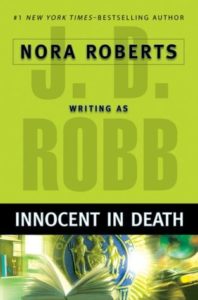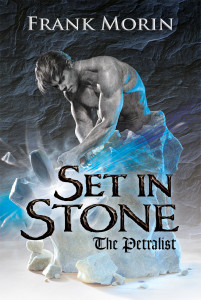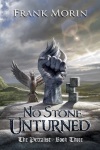I hear a lot of people talk about writer’s block. I also see a lot of commentary about loss of motivation and life interfering with writing.
While I can’t honestly say I’ve ever experienced anything that feels to me like “writer’s block” I will admit to periods of motivational doldrums, and life most certainly can get in the way of writing. But to be a writer is to write. So, when motivation is low, or even non-existent, how can you get it back?
My lowest point as a writer came over a year ago, when I was trying to complete the final book in my War Chronicles trilogy. At the same time I was trying to get my new home built, and had just started a new job, which meant spending a good bit of my “free” time learning new skills and techniques so that I could do my day job well enough to keep my day job.
In the middle of that stress and uncertainty, I was forced to admit that my ending was not working out as I wanted, and that I was going to miss several self-imposed deadlines for completing the series. I began to dread the prospect of even returning to the story and ripping apart what I had spent months working on, just to have to rebuild it again.
So, how did I get my momentum back?
If you are looking for some sort of magic bullet, or some “weird trick” that will turn your creative juices back on, I’m sorry to say that you won’t find it in this article. For me the solution was the oldest maxim in writing. “Apply butt to chair, and pen to paper.” Or more accurately in today’s world, “fingers to keyboard.”
Or to put it plainly, I sat at my desk and wrote. Even when I knew what I was writing was terrible, I wrote. I told myself that even if only five percent of my writing was worth keeping, that was still five percent more than I did by moping and trolling social media sites.
So, I wrote. And wrote. At a friend’s suggestion, I wrote a short story set in my fantasy world with entirely different characters, set hundreds of years in the past, and let that story flow. Doing so gave me some insights into the history of my world, and helped me work out the motivations and goals of the main antagonist, which got me interested in my unfinished trilogy again.
Then I sat down and reread the first two books, and all the third up to where it began to lose steam, and by the time I got to that point, a new and better ending had emerged, like Athena from Zeus’s forehead, fully formed and ready to be put onto paper.
And that finally restored my enthusiasm for the story, and I was able to get back into the groove of writing until I finished and published the final book.
It may be that the lull in motivation I encountered is what others call “writer’s block”. I never felt blocked, I just felt out of steam, stuck in neutral, all fueled up, but with no roadmap to follow. Once I finally got that roadmap into my head, writing was easy and fun again.
And that’s what it’s all supposed to be about, isn’t it? Writing should be fun. When it isn’t fun, it’s hard work, and when it’s hard work, it’s easy to find reasons to avoid it. So, when I have lost the fun, I try to find a way to get the fun back, because then writing is easy.

 Consider as an example the action/adventure film John Wick. The introduction and inciting incident occur in the first fifteen minutes of the movie and the climax occurs at roughly one hour and fifteen minutes. Taken at a very high level, what happens during the hour between those two points? First, there is a period of milieu and character work to establish the character of John Wick and the rest of the world. Then there is a beating delivered by the big bad and the big bad’s first try/fail cycle to resolve the issue without violence. This is followed by a gun fight, a short period of world exploration, a gun fight, a brief pause for recovery, a fist fight, a briefer pause for a few wise cracks, a gun fight, a yet briefer pause in which John Wick sets some stuff on fire, and once again a gun fight that ends in a capture sequence. John then escapes captivity and dives straight into the climax of the movie. The tension is not allowed to slacken for a moment because John is near constantly either in danger and/or kicking some ass.
Consider as an example the action/adventure film John Wick. The introduction and inciting incident occur in the first fifteen minutes of the movie and the climax occurs at roughly one hour and fifteen minutes. Taken at a very high level, what happens during the hour between those two points? First, there is a period of milieu and character work to establish the character of John Wick and the rest of the world. Then there is a beating delivered by the big bad and the big bad’s first try/fail cycle to resolve the issue without violence. This is followed by a gun fight, a short period of world exploration, a gun fight, a brief pause for recovery, a fist fight, a briefer pause for a few wise cracks, a gun fight, a yet briefer pause in which John Wick sets some stuff on fire, and once again a gun fight that ends in a capture sequence. John then escapes captivity and dives straight into the climax of the movie. The tension is not allowed to slacken for a moment because John is near constantly either in danger and/or kicking some ass. I believe that the story of Arrival works as well as it does because everyone goes into a first contact story expecting an overt conflict between humanity and the aliens. However, twists this trope on its head, which is intriguing in and of itself. The main story is a mystery driven by the question, “What do the aliens want?” Along the way, we the audience are given pieces of the puzzle in such a way that they don’t all come together until the very end. This plotting structure latches onto our fundamental human curiosity and pulls us forward with the illusion of progress towards getting an ultimate answer.
I believe that the story of Arrival works as well as it does because everyone goes into a first contact story expecting an overt conflict between humanity and the aliens. However, twists this trope on its head, which is intriguing in and of itself. The main story is a mystery driven by the question, “What do the aliens want?” Along the way, we the audience are given pieces of the puzzle in such a way that they don’t all come together until the very end. This plotting structure latches onto our fundamental human curiosity and pulls us forward with the illusion of progress towards getting an ultimate answer. First is by introducing conflict internal to the relationship. By giving the romantic interests compelling personal conflicts and reservations, you allow them to stand in the way of their own happiness. It’s important to note that the reasons holding your characters apart need to be fundamental to their character, something substantial enough that it can withstand several try/fail cycles and significant enough that it poses a legitimate threat to the relationship. An example of this technique can be found in the early relationship between Eve Dallas and Roarke in Naked in Death by JD Robb. During her investigation of a sensitive homicide, Lieutenant Dallas meets Roarke and sparks fly. She feels conflicted because she can’t eliminate him as a suspect in her case, but also increasingly can’t deny her developing feelings for him. Her gut tells her that Roarke is innocent, but she can’t prove it. Robb draws us through the romantic arc by having Dallas’ blooming feelings clash with her sense of duty.
First is by introducing conflict internal to the relationship. By giving the romantic interests compelling personal conflicts and reservations, you allow them to stand in the way of their own happiness. It’s important to note that the reasons holding your characters apart need to be fundamental to their character, something substantial enough that it can withstand several try/fail cycles and significant enough that it poses a legitimate threat to the relationship. An example of this technique can be found in the early relationship between Eve Dallas and Roarke in Naked in Death by JD Robb. During her investigation of a sensitive homicide, Lieutenant Dallas meets Roarke and sparks fly. She feels conflicted because she can’t eliminate him as a suspect in her case, but also increasingly can’t deny her developing feelings for him. Her gut tells her that Roarke is innocent, but she can’t prove it. Robb draws us through the romantic arc by having Dallas’ blooming feelings clash with her sense of duty. The second option is to introduce some element of external conflict, where your romantic interests strive together to try to overcome a barrier from outside the relationship. Again whatever the threat is, it needs to be big enough to possibly end the relationship. Twenty three books later in Innocent in Death, Robb introduces one of Roarke’s old girlfriends into the storyline to give Eve an extra emotional complication on top of her homicide investigation. The ex-girlfriend’s presence causes friction between Eve and Roarke and in so doing threatens their, by then well established, relationship. In both cases, the emotional distance between the characters drives our readers forward; they want to make sure that Eve and Roarke end up together.
The second option is to introduce some element of external conflict, where your romantic interests strive together to try to overcome a barrier from outside the relationship. Again whatever the threat is, it needs to be big enough to possibly end the relationship. Twenty three books later in Innocent in Death, Robb introduces one of Roarke’s old girlfriends into the storyline to give Eve an extra emotional complication on top of her homicide investigation. The ex-girlfriend’s presence causes friction between Eve and Roarke and in so doing threatens their, by then well established, relationship. In both cases, the emotional distance between the characters drives our readers forward; they want to make sure that Eve and Roarke end up together. For me, there’s nothing quite as intimidating as a page filled with a terrible story that I have written.
For me, there’s nothing quite as intimidating as a page filled with a terrible story that I have written. I ended up with about four thousand words of me repeating the same joke over and over again as told from the persepective of a main character that, by virtue of this joke, had almost no agency. It. Was. Terrible. I haven’t drafted a story this bad since high school. I gave it a day, read the thing, and cringed.
I ended up with about four thousand words of me repeating the same joke over and over again as told from the persepective of a main character that, by virtue of this joke, had almost no agency. It. Was. Terrible. I haven’t drafted a story this bad since high school. I gave it a day, read the thing, and cringed. It was my wife that saved me. After a month went by, you know what she did? She handed me a blank page. She sat me down and told me to stop thinking about the way I had written the story, and to start completely over from my original concept.
It was my wife that saved me. After a month went by, you know what she did? She handed me a blank page. She sat me down and told me to stop thinking about the way I had written the story, and to start completely over from my original concept.


